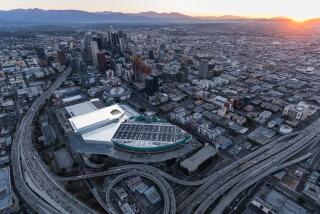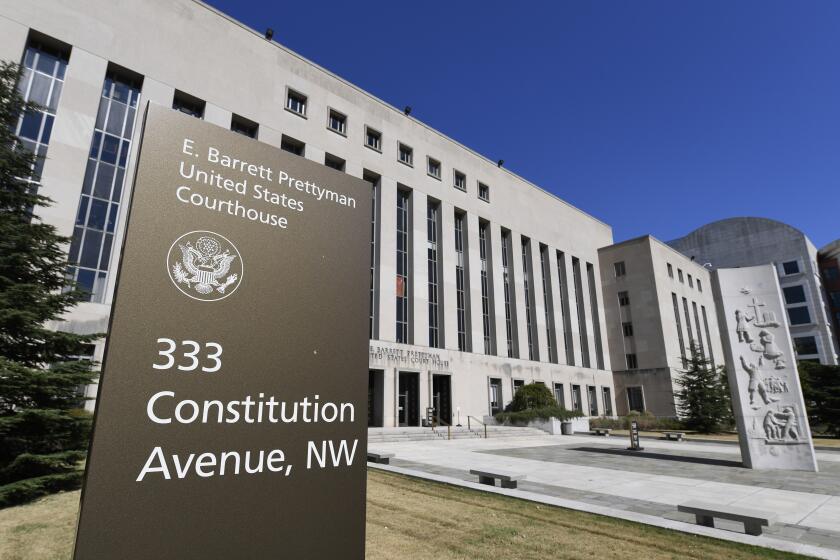Costly Super Collider Angers Panel : Research: The massive project near Dallas faces need for more funds and serious delays. Skepticism grows in Congress about all ‘Big Science’ projects.
- Share via
WASHINGTON — The government’s multibillion-dollar, superconducting super collider is facing sharply rising costs and potentially serious delays, prompting even erstwhile supporters to question the worthiness of the massive research project.
And when the smoke finally cleared Thursday after five hours of hearings on the massive particle accelerator project, it was clear that all “big science” programs will face intense and bipartisan scrutiny from increasingly skeptical members of Congress. The growing ranks of critics include many longtime science advocates who are fed up with other expensive science programs like the problem-plagued space shuttle and the flawed Hubble Space Telescope.
Citing the Energy Department’s internal documents on the super collider, Rep. Sherwood Boehlert (R-N.Y.) said during the hearing that the department is guilty of “clever evasions, wishful thinking, erroneous arithmetic, broken promises and outright lies.
“I no longer see how we can possibly proceed with this project,” said Boehlert, the ranking GOP member on the investigations and oversight subcommittee of the House Science, Space and Technology Committee.
The super collider was conceived in the mid-1980s as a tool to study the fundamental forces of nature and the subatomic particles that are the building blocks of all matter. It will be located underground some 30 miles south of Dallas.
At 54 miles in circumference, the circular device is intended to be the largest and most powerful particle accelerator in the world. It will use two rings of powerful magnets to hurl counter-rotating beams of protons around its racetrack-shaped course, forcing the particles to collide head on.
At Thursday’s hearing, Boehlert and panel chairman Howard Wolpe (D-Mich.) accused the energy agency of creating the impression that it can easily raise $1.7 billion from various countries when, in fact, such contributions are “virtually nonexistent.”
To support their allegation, the congressmen released an internal Energy Department document that was sent last fall to the White House. In the document, department officials conceded that the United States may have to “carry most of the cost of constructing the superconducting collider for several years” for lack of any significant foreign contributions.
Senior project officials went on to acknowledge that the only contribution pledged so far is $50 million from India. Still, they expressed optimism that the Bush Administration’s goal of $1.7 billion in foreign contributions can be met once ground is broken for the project and, above all, if Japan can be persuaded to donate as much as $1 billion. They said President Bush raised the issue several weeks ago with Japanese Prime Minister Toshiki Kaifu.
Boehlert and Wolpe questioned the wisdom of the department’s tight scheduling of the expected 10-year development and construction process, noting that the project will require the manufacture of nearly 10,000 highly advanced magnets--each of which must perform to exquisite perfection.
Wolpe called the department’s timetable “a formula for disaster,” since no time is allowed to resolve any problems that might arise during the project. “One slip or mistake could cascade into long and expensive delays,” he warned.
Garry W. Gibbs, acting associate director of the department’s Office of Superconducting Super Collider, said the project’s tight scheduling is intended to keep down costs. Gibbs also noted that the department has negotiated a contract to design and build certain magnet prototypes ahead of schedule and below cost estimates.
When then-President Ronald Reagan endorsed the super collider in January, 1987, the Energy Department estimated the cost at $4.4 billion. The figure, adjusted for inflation, later rose to $5.9 billion. Then, in February of this year, technical changes and a review of labor costs and other construction factors pushed the cost up to $8.2 billion.
One internal department estimate last fall calculated the eventual cost at $11.8 billion, but the department dismissed the figure as misleading, citing a variety of arcane accounting practices that left several subcommittee members unsatisfied.
“We may well be on the road to a bottomless pit,” snapped Rep. F. James Sensenbrenner Jr. (R-Wis.).
Despite such rhetoric and barring some major unforeseen setback, it does not appear that the super collider is in danger of being derailed. Indeed, the project may have developed an all-but-unstoppable momentum. Although ground has not yet been broken, the project already employs 1,100 workers, and 8,500 contracts totaling more than $100 million have been awarded to researchers and universities in 43 states.
Still, the growing doubts in Congress come at a crucial point for the super collider. For the 1992 fiscal year that begins Oct. 1, Congress is being asked to come up with $534 million for the project, more than double this year’s appropriation.
Energy Secretary James D. Watkins told the subcommittee this week in a letter that this is the “critical year” to increase funding for the project’s construction.
Each day that the project is delayed costs taxpayers more than $1 million, or as much as $475 million annually, according to officials.
Wolpe acknowledged that the intensified congressional scrutiny of all “big science” projects reflects last fall’s bipartisan budget agreement, which altered the rules of the appropriations process.
“Now all non-defense, discretionary spending programs must compete for scarce federal resources,” he said. “Every dollar spent on this program will be a dollar that is not available for educating our children, protecting the environment, retraining our work force or rebuilding the infrastructure.”
More to Read
Sign up for Essential California
The most important California stories and recommendations in your inbox every morning.
You may occasionally receive promotional content from the Los Angeles Times.










